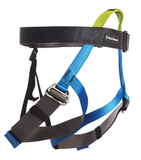There are many different types of climbing harnesses. How do you know which one is right for you? You can think of climbing harnesses like vehicles, they all get you from point A to point B. But just as you would want a small car for fuel efficiency and a truck for carrying heavy loads, you are going to want to choose a climbing harness based on what the climb ahead of you demands. Here is a list of different types of climbing harnesses you may consider.

Sport climbing harnesses are likely the most often purchased harness due to the popularity of sport climbing and the versatility of the harness. Beginner sport climbing harnesses offer a comfortable amount of padding, and lots of adjustability in the waist belt and leg loops. They usually have 4 gear loops or less. More advanced sport harnesses often cut down the number of gear loops and have less adjustability in the leg loops. The economy class, I’m a responsible adult, of harnesses.


A big wall harness is made for spending long periods of time in. They cover a much larger surface area on your legs and waist to distribute force, and have more built in padding. Big wall harnesses also have extra gear loops to carry more gear. The belay loop and tie in points are often reinforced to last longer. The truck of climbing harnesses.

A speed climbing harness gets rid of everything unnecessary. The opposite of a big wall harness. No gear loops, padding, belay loop, or tie in points. They have a waist belt, leg loops, and a single point to clip into. The webbing around the waist and leg loops are much thinner. This would be a very uncomfortable harness for most other styles of climbing. As speed climbing progresses as an Olympic sport, surely these harnesses will only advance and become lighter. The crotch rocket of harnesses.

Pro Tip:
When you first pull your harness out of its packaging you will often notice an informational manual on how to use your harness made by the harness manufacturer. Make sure to read through this manual so you understand best practices with you harness, as it may operate different than other harnesses.
Watch the video below to learn how to wear a harness:
Different Components of a Harness
The waist belt is the main safety component of a harness. It generally has a larger surface area to distribute the force for a more comfortable experience.
Gear Loops:
On the waist belt there are loops that often look like half circles or rectangles. These loops are for holding gear only such as quickdraws, carabiners, and trad gear. They are not weight rated and should never be trusted as protection.
Leg Loops:
Leg loops allow for a more comfortable experience in the harness by allowing one to sit while hanging.

Buckles:
The main types of buckles you will see on a harness are a Manual Double Backing buckle and a Automatic Double Backing buckle. Both are safe if used correctly. A Manual buckle generally only has one piece of metal. With a Manual, it is required that the webbing is weaved back through the buckle correctly so that it clamps down on the webbing. An Automatic buckle usually has two pieces of metal on it. When the waist belt webbing is weaved through the buckles correctly, the buckle automatically clamps down on the webbing when cinched tight.
Tie-in Points:
One tie-in point is located at the front of your waist belt while the other is connecting the leg loops. The tie-in points, often called the “hard points” are where nylon is attached such as rope and slings.
Belay Loop:
The belay loop is the vertical loop that connects the two tie-in points. The belay loop is where metal should go through, like carabiners. The reason carabiners should go through this single loop instead of two points is to make sure the carabiner is loaded correctly so as not to reduce its strength.
Haul Loop:
The haul loop is most often used to hold chalk bags, though it is designed to pull up tag lines and haul lines for multipitch climbing. The haul loop is usually not weight rated and not meant to be used as a point of protection.
